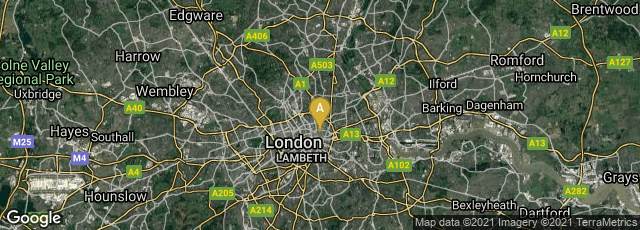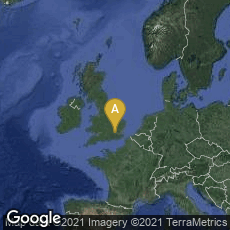

A: London, England, United Kingdom
Josiah Wedgwood's medallion, 'Am I Not a Man and a Brother?', 1787. "Although the kneeling black figure is docile and supplicatory (reflecting nothing of the frequent fierce rebellions by enslaved people in the New World plantations), the image nonetheless helped to galvanise support for the abolitionist cause. Benjamin Franklin declared that the medallion's effectiveness was 'equal to that of the best written Pamphlet, in procuring favour to those oppressed People.' " (http://www.bbc.co.uk/history/british/abolition/africans_in_art_gallery_02.shtml).
On May 22nd, 1787, twelve men met at 2 George Yard in the City of London, in what was then a printing shop and bookstore, to set up the Society for Effecting the Abolition of the Slave Trade (or The Society for the Abolition of the Slave Trade). Nine of the twelve founders were Quakers: John Barton, William Dillwyn, George Harrison, Samuel Hoare Jr., Joseph Hooper, John Lloyd, Joseph Woods Sr., James Phillips and Richard Phillips. The other three were Anglicans: Philip Sansom and most notably, Granville Sharp and Thomas Clarkson. The nine Quakers, as non-conformists, were prevented from standing for Parliament, while the presence of the three Anglicans in the Society strengthened the committee's likelihood of influencing Parliament.
The Society was formed to raise public awareness in order to lobby for a new law that would abolish the slave trade, and enforce this law on the high seas across the British empire and in West Africa, so that Africans would no longer live in fear of being captured and sold into slavery. Methods used to achieve these goals included publishing anti-slavery books and posters and tours around cities in England. One of the first of the anti-slavery books was Clarkson's Essay on the Impolicy of the African Slave Trade (1788).
One of the key supporters of the committee was Josiah Wedgwood, who commissioned a bronze token and a ceramic medallion from the artist William Hackwood in 1787. Wedgewood's slave tokens and medallions, picturing an African slave on one knee in shackles with the caption "Am I not a man and a brother?" became the most famous image of a black person in 18th century art, and helped significantly to promote the abolitionist campaign. Other objects sold to promote the anti-slavery movement included a sugar bowl with a gold inscription reading,"East India Sugar not made by Slaves."
The movement to end slavery has been called "the first great human rights campaign." In 1791, as a consequence of the work by the committee, William Wilberforce brought into parliament the first bill to abolish the slave trade. Though it was beaten 163 votes to 88, momentum was gradually building for the abolition of slavery. An Act for the Abolition of the Slave Trade became law in 1807, although the institution of slavery was not officially abolished until the Slavery Abolition Act of 1833.